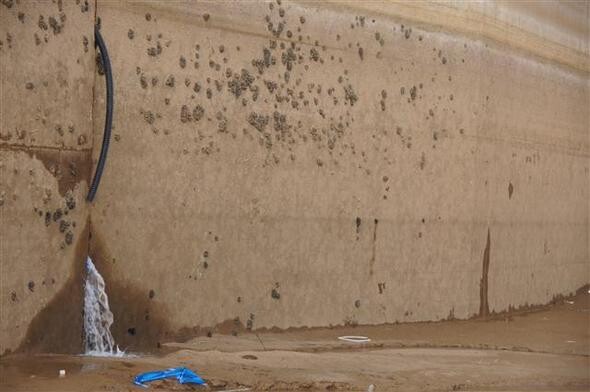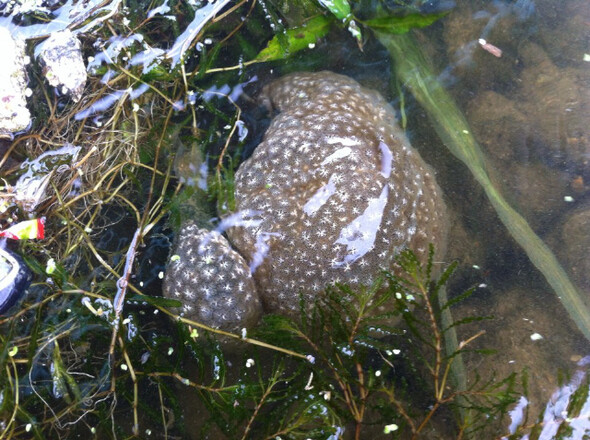hankyoreh
Links to other country sites 다른 나라 사이트 링크
Taxpayers getting stuck paying back massive Four Major Rivers Project debt

By Kim Kyu-won and Kim Won-chul, staff reporters
The Four Major Rivers Project, an effort controversially pushed by former President Lee Myung-bak (in office from 2008-13), is turning into a money pit. Liabilities for the Korea Water Resources Corporation (K-water) are projected to jump from 1.9 trillion won (US$1.88 billion) at the outset in 2008 to over 17 trillion won (US$16.8 billion) in 2017.
The Ministry of Land, Infrastructure and Transport (MLIT) is set to present ways in late August to repay 8 trillion won (US$7.9 billion) in K-water debt from the project. Son Byeong-seok, head of the ministry’s water resources policy office, said the plan came after a September 2009 national policy coordination meeting at which it was decided to have the full interest burden subsidized by the government, with profits used to pay back the principal.
“Any shortfall was to be repaid when the project was completed,” Son explained. “That plan is what we’re developing.”
The debt and interest repayment plan is expected to draw serious criticism, as it would mean the state paying down even part of the principal on K-water’s debt.
Civic groups that have bitterly opposed the project since it was first launched are arguing that the time hasn’t yet come to discuss repaying K-water’s liabilities.
Attorney Kim Young-hee filed a complaint with prosecutors in October 2013 accusing Lee and 58 project officials of breach of trust and violation of the National Finance Act.
“The first thing we need is an investigation into the illegal appropriation and waste of national budget funds by the President and his ministers,” said Kim. “The debt repayment issue can be discussed later.”

■ The history of K-water’s ballooning debt
In total, K-water will have invested 7.978 billion won (US$7.9 billion) in the Four Major Rivers Project. Some of those investments are still ongoing, including the Mt. Bohyeon Dam (scheduled for completion by the end of the year), Yeongju Dam (to be completed next year) and the Andong and Inha Dams. Its investment in the project will be complete with an additional 581.8 billion won (US$576.4 million) in its 2014-15 budget.
K-water also invested 2,245.8 billion won (US$2.23 billion) between 2009 and 2011 in its own Gyeongin Waterway project, a kind of miniature version of the Four Major Rivers Project. With the two separate projects, its liabilities rose from 1.962.3 billion won (US$1.94 billion) before the project in 2008 to 13.998.5 billion won (US$13.9 billion) in 2013 - an increase of 12.036.2 billion won (US$11.9 billion). Of that amount, 10.223.8 billion won (US$10.1 billion) went toward the Four Major Rivers and Gyeongin Ara Waterway.
The government’s interest burden on the Four Major Rivers Project, the subject of ongoing investment, is 1.318.6 billion won (US$1.3 billion), or roughly 17% of K-water’s liabilities. The 2015 budget recently requested by MLIT from the Ministry of Strategy and Finance included 317 billion won (US$314 million) for interest repayment and 80 billion won (US$79.3 million) for principal repayment, bringing the total of K-water debt and interest covered by the government to 1.715.6 billion won (US$1.7 billion) by 2015. At the current scale of debt, it would need to pay more than 320 billion won (US$317 million) a year just in interest.
Some are predicting K-water’s liabilities could balloon even more, reaching as much as 17.117 billion won (US$17 billion) in 2017. It would be a 15 trillion won (US$14.9 billion) increase from the 1.9 trillion won in 2008 liabilities, and over 3 trillion won more than the 14 trillion won recorded in 2013.
“Our mid to long-term financial plan had liabilities rising to 19 trillion won (US$18.8 billion), but that was reduced by 1.9 trillion won (US$1.88 billion) through debt-cutting measures,” K-water explained.
The main reason for all the debt falling on K-water was Lee’s decision to enlist it in the project in an effort to get it finished before his term ended in 2013. Indeed, K-water initially balked at the idea. Results from advance reviews by four law firms showed the project lacked profit potential and did not fit within the scope of K-water’s duties. But on Sept. 25, 2009, the administration decided at a national policy coordination meeting to provide financial and institutional support for the recovery of investment costs. Three days later, the K-water board of directors unanimously approved the investment.
■ Who pays it back and how?
The administration’s 2015 budget request for principal repayment on K-water debt amounts to 80 billion won. At that rate, it would take a full century to repay all of the corporation’s liabilities from the project - and that doesn’t include the yearly interest repayment, which came to 320 billion won in 2014. The interest is set to drop as more of the principal is paid down, but the MLIT and K-water are still paying hundreds of billions of won each year on liabilities without anything to show for it.
K-water announced a set of debt-cutting measures, but it has also admitted it has no way of paying back the full 8 trillion won. In its 2013 management report, it indicated that it would cover 200 billion won (US$198 million) of the investment through total project cost adjustments and 400 billion won (US$396 million) through dam usage rights. Another 700 billion won (US$694 million) would come from projects involving so-called “hydrophilic zones,” including the Eco Delta City, a new city project under construction around Busan’s Myeongji neighborhood. This adds up to 1.3 trillion won in principal that K-water would be covering itself, with another 6,678 billion won (US$6.6 billion) to be requested from the government in support. It does not include the yearly interest burden, which stood at 320 billion won in 2014. And with Eco Delta City’s future profitability uncertain, the project could end up being scrapped, adding even more to the government’s subsidy burden.

■ What is the total cost of investment and maintenance?
The total amount of money invested in the Four Major Rivers Project was 22.29 trillion won (US$22.08 billion). Adding the trial project, the Gyeongin Ara Waterway, interest, and maintenance and upkeep costs, the total rises to 26.25 trillion won as of 2014.
K-water shouldered 7.98 trillion won of the 22.29 trillion won investment, the most of any government agency. This was followed by the MLIT with 7.45 trillion won, the Ministry of Environment with 3.89 trillion won, and the Ministry of Agriculture, Food, and Rural Affairs with 2.97 trillion won.
It appears that K-water took on the largest share because a significant portion of the government budget was fixed, making it difficult to raise 22 trillion won in a short period of time. Presumably, another major reason was the fact that K-water - unlike government ministries - does not have to carry out a preliminary feasibility study.
As of 2014, K-water alone is pouring more than 100 billion won (US$99.08 million) a year in maintenance costs for the Four Major Rivers Project, even aside from the 7.98 trillion won in investment and the 1.32 trillion won in interest. Maintenance and upkeep costs 136.8 billion won in 2012 (the year when the Four Major Rivers Project was basically completed), 135.3 billion won in 2013, and 131.5 billion won in 2014, for a total of 403.6 billion won. The maintenance budget in 2014 included 44.9 billion won for waterfront facilities, 29.1 billion won for weirs, and 57.5 billion won for flood prevention facilities for the main channel.
“In addition to the massive initial cost of the Four Major Rivers Project, we continue to pour money down the drain, spending more than 450 billion won on interest and maintenance each year,” said New Politics Alliance for Democracy (NPAD) lawmaker Lee Mi-kyung, a member of the National Assembly‘s Land, Transport, and Maritime Affairs Committee.
“We must move quickly to punish those responsible for the Four Major Rivers Project, which was a confidence trick played against the South Korean public, and find a way to make the four rivers sustainable waterways,” Lee said.
Please direct questions or comments to [english@hani.co.kr]

Editorial・opinion
![[Column] Season 2 of special prosecutor probe may be coming to Korea soon [Column] Season 2 of special prosecutor probe may be coming to Korea soon](https://flexible.img.hani.co.kr/flexible/normal/500/300/imgdb/original/2024/0426/3317141030699447.jpg) [Column] Season 2 of special prosecutor probe may be coming to Korea soon
[Column] Season 2 of special prosecutor probe may be coming to Korea soon![[Column] Park Geun-hye déjà vu in Yoon Suk-yeol [Column] Park Geun-hye déjà vu in Yoon Suk-yeol](https://flexible.img.hani.co.kr/flexible/normal/500/300/imgdb/original/2024/0424/651713945113788.jpg) [Column] Park Geun-hye déjà vu in Yoon Suk-yeol
[Column] Park Geun-hye déjà vu in Yoon Suk-yeol- [Editorial] New weight of N. Korea’s nuclear threats makes dialogue all the more urgent
- [Guest essay] The real reason Korea’s new right wants to dub Rhee a founding father
- [Column] ‘Choson’: Is it time we start referring to N. Korea in its own terms?
- [Editorial] Japan’s rewriting of history with Korea has gone too far
- [Column] The president’s questionable capacity for dialogue
- [Column] Are chaebol firms just pizza pies for families to divvy up as they please?
- [Column] Has Korea, too, crossed the Rubicon on China?
- [Correspondent’s column] In Japan’s alliance with US, echoes of its past alliances with UK
Most viewed articles
- 1‘We must say no’: Seoul defense chief on Korean, USFK involvement in hypothetical Taiwan crisis
- 2N. Korean delegation’s trip to Iran shows how Pyongyang is leveraging ties with Moscow
- 3‘Weddingflation’ breaks the bank for Korean couples-to-be
- 4Korea sees more deaths than births for 52nd consecutive month in February
- 5[Editorial] New weight of N. Korea’s nuclear threats makes dialogue all the more urgent
- 6[Column] Park Geun-hye déjà vu in Yoon Suk-yeol
- 7[Column] Has Korea, too, crossed the Rubicon on China?
- 8[Guest essay] The real reason Korea’s new right wants to dub Rhee a founding father
- 9Will NewJeans end up collateral damage in internal feud at K-pop juggernaut Hybe?
- 10Why Korea shouldn’t welcome Japan’s newly beefed up defense cooperation with US